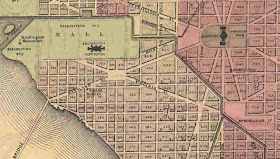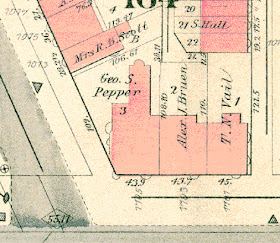 In the
early years of the United States, there was great interest in creating canals
within cities emulating European counterparts.
These were not for aesthetics, but for commerce. Pierre Charles L’Enfant included one in his
design for the Capital City, but Commissioners in 1792 deemed it too expensive
to construct. A lottery held in 1796 to
raise funds for its construction was unsuccessful.
In the
early years of the United States, there was great interest in creating canals
within cities emulating European counterparts.
These were not for aesthetics, but for commerce. Pierre Charles L’Enfant included one in his
design for the Capital City, but Commissioners in 1792 deemed it too expensive
to construct. A lottery held in 1796 to
raise funds for its construction was unsuccessful.
In 1802,
Congress granted a charter for the Washington Canal Company, and construction
began in several portions of the planned route.
The canal was to connect the Anacostia River (then known as the Eastern
Branch), which was navigable into Maryland, with the Potomac, which was seen as
a gateway to the West. It would later
connect to the C&O Canal.
The canal
opened to much fanfare in November of 1815.
It stretched from an entrance point near the Washington Navy Yard,
proceeded north and west with several branches including James and Tiber
creeks, and ran westerly exactly where Constitution Avenue exists today. It joined the Potomac River just south of the
White House, long before the western half of the National Mall had been filled
in.
In 1833, an
extension of the C&O Canal was completed to incorporate the Washington
Canal. Around 1835, a lock keeper’s
house was built at the eastern terminus of the C&O Canal, where the C&O
Canal emptied into Tiber Creek and the Potomac River. It still stands at the
southwest corner of Constitution Avenue, and 17th Street, NW.
The canal
was cleaned and dredged in 1849, but the city’s promise to provide work and
matching funds to Congressional budgets for the canal never materialized. In an era when most residents did not know
how to swim, the canal provided a death trap to hundreds, especially young
curious children or those wandering the city after a visit to a local saloon.
In the
1850s, Washington and other cities had begun to utilize railroads for most of
the commerce transportation, and both the Washington and C&O canals were
neglected. During the Civil War when the
city’s population boomed, the canal was used as a storm drain and open
sewer. It was also a breeding ground for
mosquitoes carrying malaria, and was such a health threat that it prompted the
abandonment of the Van Ness mansion (see Van Ness mansion, pg. ?)
Various proposals were introduced
to either rehabilitate the city canal or fill it in. In 1871, the city’s
controversial head of the Public Works Alexander “Boss” Shepherd had the Tiber
Creek portion of the canal be covered over, which took years to complete. The new street that was constructed over this
portion of the canal was initially designated as B Street, NW, but is known
today as Constitution Avenue, NW.
The southern portion of the
Washington City Canal remained open for years afterwards, but eventually was
also paved over. A street constructed south of the Capitol over that section of
the canal now connects Independence Avenue, SW, and E Street, SE. Formerly designated as Canal Street, the
northernmost section of the street was later renamed to Washington Avenue in
commemoration of the state of Washington.
Copyright Paul K. Williams









